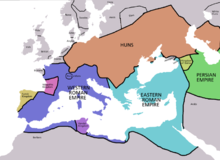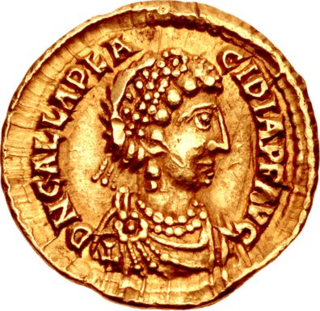
Galla Placidia, daughter of the Roman emperor Theodosius I, was a mother, tutor, and advisor to emperor Valentinian III. She was queen consort to Ataulf, king of the Visigoths from 414 until his death in 415, briefly empress consort to Constantius III in 421, and managed the government administration as a regent during the early reign of Valentinian III until her death.
The 430s decade ran from January 1, 430, to December 31, 439.
The 450s decade ran from January 1, 450, to December 31, 459.

Year 453 (CDLIII) was a common year starting on Thursday of the Julian calendar. At the time, it was known as the Year of the Consulship of Opilio and Vincomalus. The denomination 453 for this year has been used since the early medieval period, when the Anno Domini calendar era became the prevalent method in Europe for naming years.

Year 408 (CDVIII) was a leap year starting on Wednesday of the Julian calendar. At the time, it was known as the Year of the Consulship of Bassus and Philippus. The denomination 408 for this year has been used since the early medieval period, when the Anno Domini calendar era became the prevalent method in Europe for naming years.
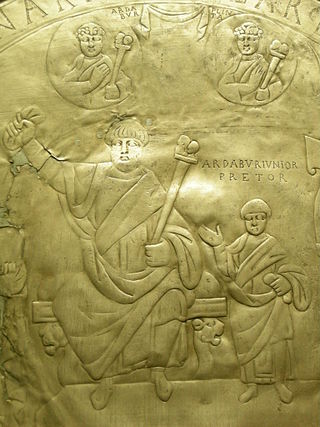
Year 434 (CDXXXIV) was a common year starting on Monday of the Julian calendar. At the time, it was known as the Year of the Consulship of Aspar and Areobindus. The denomination 434 for this year has been used since the early medieval period, when the Anno Domini calendar era became the prevalent method in Europe for naming years.

Year 439 (CDXXXIX) was a common year starting on Sunday of the Julian calendar. At the time, it was known as the Year of the Consulship of Theodosius and Festus. The denomination 439 for this year has been used since the early medieval period, when the Anno Domini calendar era became the prevalent method in Europe for naming years.
The 440s decade ran from January 1, 440, to December 31, 449.
Year 454 (CDLIV) was a common year starting on Friday of the Julian calendar. At the time, it was known as the Year of the Consulship of Aetius and Studius. The denomination 454 for this year has been used since the early medieval period, when the Anno Domini calendar era became the prevalent method in Europe for naming years.
Year 380 (CCCLXXX) was a leap year starting on Wednesday of the Julian calendar. At the time, it was known as the Year of the Consulship of Augustus and Augustus. The denomination 380 for this year has been used since the early medieval period, when the Anno Domini calendar era became the prevalent method in Europe for naming years.
Year 425 (CDXXV) was a common year starting on Thursday of the Julian calendar. At the time, it was known as the Year of the Consulship of Theodosius and Valentinianus. The denomination 425 for this year has been used since the early medieval period, when the Anno Domini calendar era became the prevalent method in Europe for naming years.

Year 460 (CDLX) was a leap year starting on Friday of the Julian calendar. At the time, it was known as the Year of the Consulship of Magnus and Apollonius. The denomination 460 for this year has been used since the early medieval period, when the Anno Domini calendar era became the prevalent method in Europe for naming years.
Year 442 (CDXLII) was a common year starting on Thursday of the Julian calendar. At the time, it was known as the Year of the Consulship of Dioscorus and Eudoxius. The denomination 442 for this year has been used since the early medieval period, when the Anno Domini calendar era became the prevalent method in Europe for naming years.

Year 441 (CDXLI) was a common year starting on Wednesday of the Julian calendar. At the time, it was known as the Year of the Consulship of Seleucus without colleague. The denomination 441 for this year has been used since the early medieval period, when the Anno Domini calendar era became the prevalent method in Europe for naming years.

Marcian was Roman emperor of the East from 450 to 457. Very little of his life before becoming emperor is known, other than that he was a domesticus who served under the commanders Ardabur and his son Aspar for fifteen years. After the death of Emperor Theodosius II on 28 July 450, Marcian was made a candidate for the throne by Aspar, who held much influence because of his military power. After a month of negotiations Pulcheria, Theodosius' sister, agreed to marry Marcian. Zeno, a military leader whose influence was similar to Aspar's, may have been involved in these negotiations, as he was given the high-ranking court title of patrician upon Marcian's accession. Marcian was elected and inaugurated on 25 August 450.
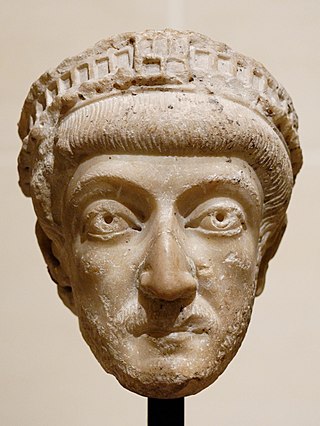
Theodosius II was Roman emperor from 402 to 450. He was proclaimed augustus as an infant and ruled as the Eastern Empire's sole emperor after the death of his father, Arcadius, in 408. His reign was marked by the promulgation of the Theodosian law code and the construction of the Theodosian Walls of Constantinople. He also presided over the outbreak of two great Christological controversies, Nestorianism and Eutychianism.
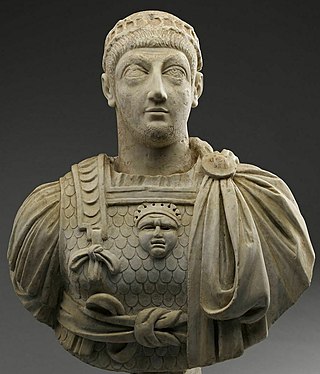
Valentinian III was Roman emperor in the West from 425 to 455. Made emperor in childhood, his reign over the Roman Empire was one of the longest, but was dominated by powerful generals vying for power amid civil wars and the invasions of Late antiquity's Migration Period, including the campaigns of Attila the Hun.
Chrysaphius was a eunuch in the Eastern Roman court who became the chief minister of Theodosius II. Having a great influence on the rule of the empire during his ascendancy, he pursued a policy of appeasement towards the Huns, which cost the empire far more gold than any military campaign, while amassing a vast fortune in bribes himself. He is depicted as a sinister figure in all the ancient accounts.
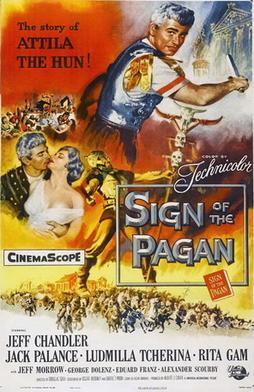
Sign of the Pagan is a 1954 American historical drama film directed by Douglas Sirk, shot in CinemaScope, and released by Universal Pictures. The film stars Jeff Chandler, Jack Palance, Ludmilla Tchérina, and Rita Gam.

The Eastern Roman Empire was ruled by the Theodosian dynasty from 379, the accession of Theodosius I, to 457, the death of Marcian. The rule of the Theodosian dynasty saw the final East-West division of the Roman Empire, between Arcadius and Honorius in 395. Whilst divisions of the Roman Empire had occurred before, the Empire would never again be fully reunited. The reign of the sons of Theodosius I contributed heavily to the crisis that under the fifth century eventually resulted in the complete collapse of western Roman court.
